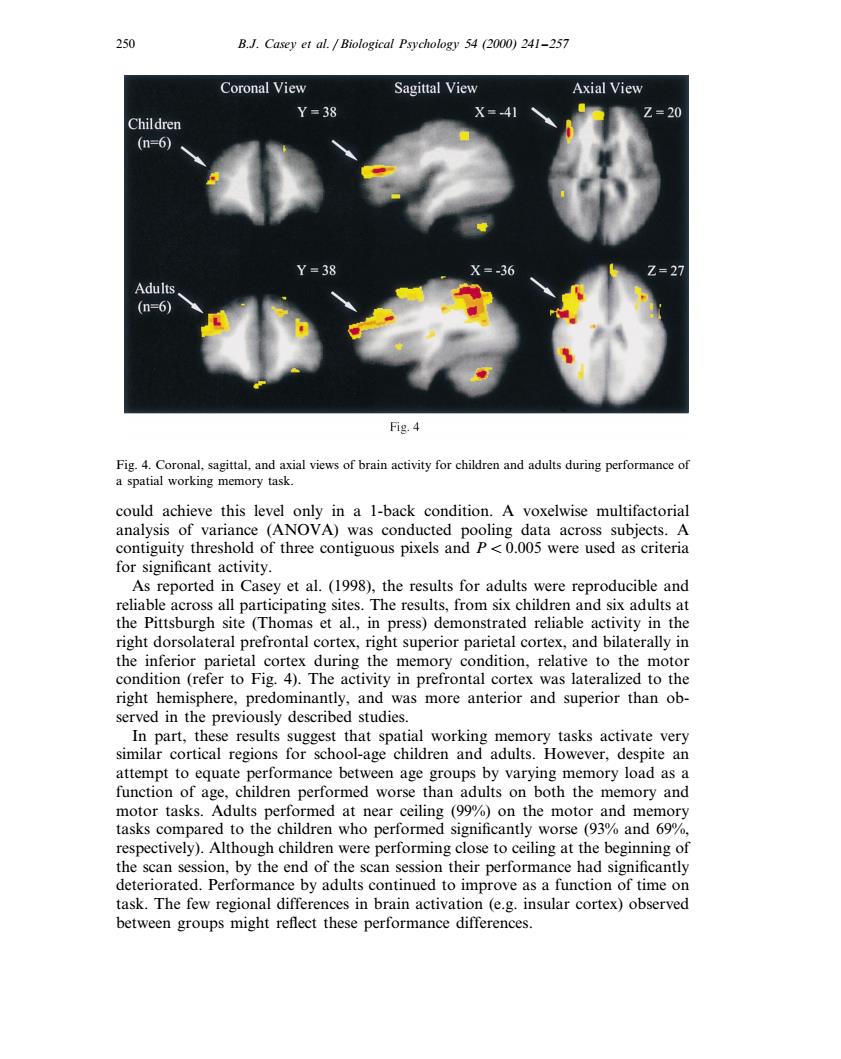正在加载图片...

250 B.J.Casey et al./Biological Psychology 54(2000)241-257 Coronal View Sagittal View Axial View Y=38 X=41 7=20 Adults (n=6) Fig.4 sagittal,and axial views of brain activity for children and adults during performance of could achieve this level only in a 1-back condition.A voxelwise multifactorial comtiguity threo tho wereused as crieria analysi for significant activity. As reported in Casey et al.(1998),the results for adults were reproducible and reliable across all participating sites.The results,from six children and six adults at the Pittsburgh site (Thomas et al.,in press)demonstrated reliable activity in the right dorsolateral prefrontal cortex,right superior parietal cortex,and bilaterally in the inferior parietal cortex during the memory condition,relative to the motor condition (refer to Fig.4).The activity in prefrontal cortex was lateralized to the right hemisphere,predominantly,and was more anterior and superior than ob- served in the previously described studies results that tial working cortical age attempt to equate bet een age groups by varying me nory load as function of age, than adults on both the memory and motor tasks.Adults performed at near ceiling (99%)on the motor and memory tasks compared to the children who performed significantly worse (93%and 69% respectively).Although children were performing close to ceiling at the beginning of the scan session,by the end of the scan session their performance had significantly deteriorated.Performance by adults continued to improve as a function of time on task.The few regional differences in brain activation (e.g.insular cortex)observed between groups might reflect these performance differences. 250 B.J. Casey et al. / Biological Psychology 54 (2000) 241–257 Fig. 4. Coronal, sagittal, and axial views of brain activity for children and adults during performance of a spatial working memory task. could achieve this level only in a 1-back condition. A voxelwise multifactorial analysis of variance (ANOVA) was conducted pooling data across subjects. A contiguity threshold of three contiguous pixels and PB0.005 were used as criteria for significant activity. As reported in Casey et al. (1998), the results for adults were reproducible and reliable across all participating sites. The results, from six children and six adults at the Pittsburgh site (Thomas et al., in press) demonstrated reliable activity in the right dorsolateral prefrontal cortex, right superior parietal cortex, and bilaterally in the inferior parietal cortex during the memory condition, relative to the motor condition (refer to Fig. 4). The activity in prefrontal cortex was lateralized to the right hemisphere, predominantly, and was more anterior and superior than observed in the previously described studies. In part, these results suggest that spatial working memory tasks activate very similar cortical regions for school-age children and adults. However, despite an attempt to equate performance between age groups by varying memory load as a function of age, children performed worse than adults on both the memory and motor tasks. Adults performed at near ceiling (99%) on the motor and memory tasks compared to the children who performed significantly worse (93% and 69%, respectively). Although children were performing close to ceiling at the beginning of the scan session, by the end of the scan session their performance had significantly deteriorated. Performance by adults continued to improve as a function of time on task. The few regional differences in brain activation (e.g. insular cortex) observed between groups might reflect these performance differences